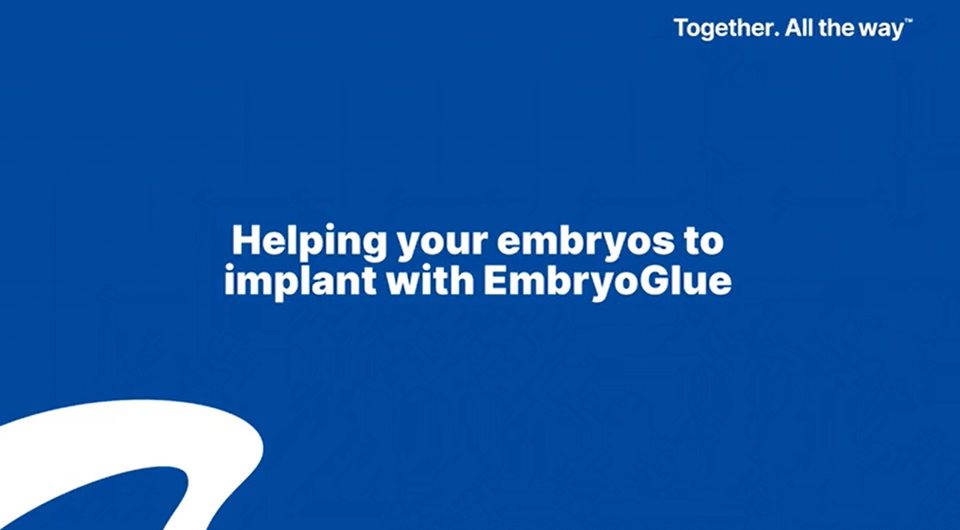
Helping your embryos to implant with EmbryoGlue
The IVF journey and the embryo transfer step
Maximise the chance of your efforts
The process of going through an IVF treatment is a physical and mental effort. After egg retrieval your embryos have grown in the laboratory incubator for a few days, perhaps they have gone through additional genetic testing and the best one is selected for embryo transfer. At this point in time the transfer is the last step of the process for the embryo. To maximise the chance of success, the transfer can be made with the help of EmbryoGlue®.


Helping your embryos to implant with EmbryoGlue
One of the most important steps in IVF is embryo transfer. Give your embryos a helping hand with EmbryoGlue.
Watch this movie for a short explanation of how EmbryoGlue works and may benefit your IVF treatment.
How does it work?
EmbryoGlue is not an actual glue, it is a solution used when transferring the embryo back into the uterus. The solution has an optimal composition by having a high concentration of hyaluronan to support implantation of the embryo to the womb 1. In practice, the high concentration of hyaluronan thickens EmbryoGlue so that it becomes more similar to the texture of the fluids in the womb. Thus, it is believed that improved mixing of these fluids may minimise embryo drifting 2, 5
Hyaluronan binds to molecules on the uterine surface and acts like a bridge between the embryo and the womb 6, 9. This helps the embryo to implant in the womb much like during natural conception.


More children born with EmbryoGlue
EmbryoGlue has been used clinically since 2003 and is the most documented embryo transfer medium1, 10. It has been shown to increase both implantation, pregnancy rates and live birth rates. Data from 26 quality approved clinical studies was collected in a review performed by the Cochrane collaboration. Data on live births from more than 4,000 transfers shows a 20% increase in chance if using EmbyroGlue1.
We maximised our chances by using EmbryoGlue and we named our son Maxime. We are now a complete and happy family and we are not sure we would have been as successful if we hadn’t used EmbryoGlue. It worked for us and it might work for someone else too.
Corrie and Alexandra battled infertility for 7 years and went through two cycles of IVF. In their second cycle, the couple used EmbryoGlue for their embryo transfer.
Improve your chances with EmbryoGlue
Each fertility treatment is unique – ask your doctor if EmbryoGlue is an option for your treatment.

References
1. Hyemann, D. Hyaluronic acid in embryo transfer media for assisted reproductive technologies (Review). Cochrane Database of Systematic Reviews 2020, Issue 9. DOI:10.1002/14651858.CD007421.pub4.
2. Lee CN and Ax RL Concentration and composition of glycosaminoglycans in the female bovine reproductive tract. J Dairy Science 67:2006-2009 (1984).
3. Suchanek E et al. Follicular fluid contents of hyaluronic acid, follicle-stimulating hormone and steroids relative to the success of in vitro fertilization of human oocytes. Fert.Steril 62:347-352 (1994).
4. Rodiguez-Martinez et al. In Gametes: Development and Function, Serono symposia. Rodriguez-Martinez H et al (1998) GAGs and spermatozoa competence in vivo and in vitro. In Gametes: Development and Function pp 239-272 Eds A Lauria, et al. Serono Symposia, Roma (1998).
5. Kano K et al (1998) Effects of glycosaminoglycans on the development of in vitro-matured and fertilized porcine oocytes to the blastocyst stage in vitro. Biol of Reprod 58:1226-1232 (1998).
6. Campbell S et al (1995) CD44 is expressed throughout preimplantation human embryo development. Hum Reprod 10:425-430 (1995).
7. Behzad F et al (1994) Expression of two isoforms of CD44 in human endometrium. Biol Reprod 51:739-747 (1994).
8. Yaegashi N et al (1995) Menstrual cycle dependent expression of CD44 in normal human endometrium. Hum Pathol 26:862-65 (1995).
9. Stojkovic M et al (2003) Developmental regulation of hyaluronan-binding protein (RHAMM/IHABP) expression in early bovine embryos. Biol Reprod 68:60-66 (2003).
10. Schoolcraft W, Lane M, Stevens J, Gardner DK (2002) Increased hyaluronan concentration in the embryo transfer medium results in significant increase in human embryo implantation rate. Fertil Steril 76 Suppl 3 S5.

